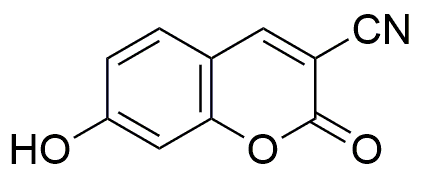3-Cyanoumbelliferone is widely utilized in research focused on:
- Fluorescent Probes: This compound is often used as a fluorescent probe in biochemical assays, allowing researchers to visualize and track biological processes in real time.
- Antioxidant Studies: It serves as a valuable tool in studying antioxidant properties, helping researchers understand how certain compounds can protect cells from oxidative stress.
- Drug Development: Its unique structure makes it a candidate for developing new pharmaceuticals, particularly in the field of cancer research, where it may help in designing targeted therapies.
- Photodynamic Therapy: 3-Cyanoumbelliferone is explored for its potential in photodynamic therapy, a treatment that uses light-sensitive compounds to kill cancer cells.
- Analytical Chemistry: This compound is utilized in analytical methods to detect and quantify various substances, enhancing the accuracy of chemical analysis in laboratories.
Información general
Propiedades
Seguridad y normativas
Aplicaciones
3-Cyanoumbelliferone is widely utilized in research focused on:
- Fluorescent Probes: This compound is often used as a fluorescent probe in biochemical assays, allowing researchers to visualize and track biological processes in real time.
- Antioxidant Studies: It serves as a valuable tool in studying antioxidant properties, helping researchers understand how certain compounds can protect cells from oxidative stress.
- Drug Development: Its unique structure makes it a candidate for developing new pharmaceuticals, particularly in the field of cancer research, where it may help in designing targeted therapies.
- Photodynamic Therapy: 3-Cyanoumbelliferone is explored for its potential in photodynamic therapy, a treatment that uses light-sensitive compounds to kill cancer cells.
- Analytical Chemistry: This compound is utilized in analytical methods to detect and quantify various substances, enhancing the accuracy of chemical analysis in laboratories.
Documentos
Hojas de datos de seguridad (HDS)
La SDS proporciona información de seguridad completa sobre la manipulación, el almacenamiento y la eliminación del producto.
Especificación del producto (PS)
La PS proporciona un desglose completo de las propiedades del producto, incluida la composición química, el estado físico, la pureza y los requisitos de almacenamiento. También detalla los rangos de calidad aceptables y las aplicaciones previstas del producto.
Certificados de análisis (COA)
Busque certificados de análisis (COA) ingresando el número de lote del producto. Los números de lote y de partida se pueden encontrar en la etiqueta de un producto después de las palabras "Lote" o "Lote".
Número de catálogo
Número de lote/lote
Certificados de origen (COO)
Este certificado de origen confirma el país en el que se fabricó el producto y también detalla los materiales y componentes utilizados en él y si se deriva de fuentes naturales, sintéticas u otras fuentes específicas. Este certificado puede ser necesario para cumplir con las normativas aduaneras, comerciales y regulatorias.
Número de catálogo
Número de lote/lote
Hojas de datos de seguridad (HDS)
La SDS proporciona información de seguridad completa sobre la manipulación, el almacenamiento y la eliminación del producto.
DownloadEspecificación del producto (PS)
La PS proporciona un desglose completo de las propiedades del producto, incluida la composición química, el estado físico, la pureza y los requisitos de almacenamiento. También detalla los rangos de calidad aceptables y las aplicaciones previstas del producto.
DownloadCertificados de análisis (COA)
Busque certificados de análisis (COA) ingresando el número de lote del producto. Los números de lote y de partida se pueden encontrar en la etiqueta de un producto después de las palabras "Lote" o "Lote".
Número de catálogo
Número de lote/lote
Certificados de origen (COO)
Este certificado de origen confirma el país en el que se fabricó el producto y también detalla los materiales y componentes utilizados en él y si se deriva de fuentes naturales, sintéticas u otras fuentes específicas. Este certificado puede ser necesario para cumplir con las normativas aduaneras, comerciales y regulatorias.

